The secret life of an alpaca farmer: How this Karaka resident balances big-city glamour with raising 150 alpacas

Her working life is dedicated to the glamour and romance of weddings, but another job has stolen Lisa Charteris’ heart.
Words: Nadene Hall Photos: Sheryl Burson
Who: Lisa Charteris, Waters Edge Alpacas
What: 150+ alpaca
Land: 2ha (5 acres) plus 34ha (85 acre) lease block
Where: Karaka, 40km south of Auckland
For much of her working year, Lisa Charteris has clients who are all about big white dresses, shoes, jewellery, flowers, cakes, and fairy lights, in her role as director of Auckland’s annual Grand Wedding Show.
But Lisa’s other job is as far from all that glamour as you can get. She’s still impeccably made up, but she’ll be in her gumboots, hauling troughs, checking fence lines, or peering down a microscope at faecal samples. Conversation is dominated by talk of fibre, facial eczema, and the fascination she has with her four-legged ‘colleagues’.
Lisa is the farm manager for her parent’s herd of 150 alpaca. They roam over two properties: the Charteris family’s 2ha block, and the grazing land on Te Hihi Estate, the former luxury property of millionaire Eric Watson.

It’s an enormous change from six years ago when her mother Toni first caught the alpaca ‘bug’ and bought two as pets.
“Then we went along to our local Franklin A&P show and saw the alpaca section being judged,” says Lisa. “Our whole family is very competitive. We spoke to a breeder and went along to his farm… and bought our first lot of 10.”
When Lisa says ‘very competitive’, she’s not exaggerating. The animals she cares for are mostly the result of some amazing technology which has allowed the Charteris family to leap from complete beginners to champions in just a few years. The walls of their barn are plastered with dozens of champion ribbons, and supreme champion cups line the shelves.

“It’s because of mum and dad’s age at the time they started,” says Lisa. “A lot of people with alpacas in NZ are generally slightly older, it’s the kind of thing they do leading into retirement. If you want to get really good and go to all the shows, it’s expensive, and (my parents) wanted to try and jump ahead as quickly as possible.”
That’s difficult when an alpaca’s gestation is 11 months, and you might end up with just an average cria.
“Most people can only afford to start with a couple of good females, and a male. You might have three or four babies, and they might not be good so it might take years and years and years, getting just a little better quality each year.”
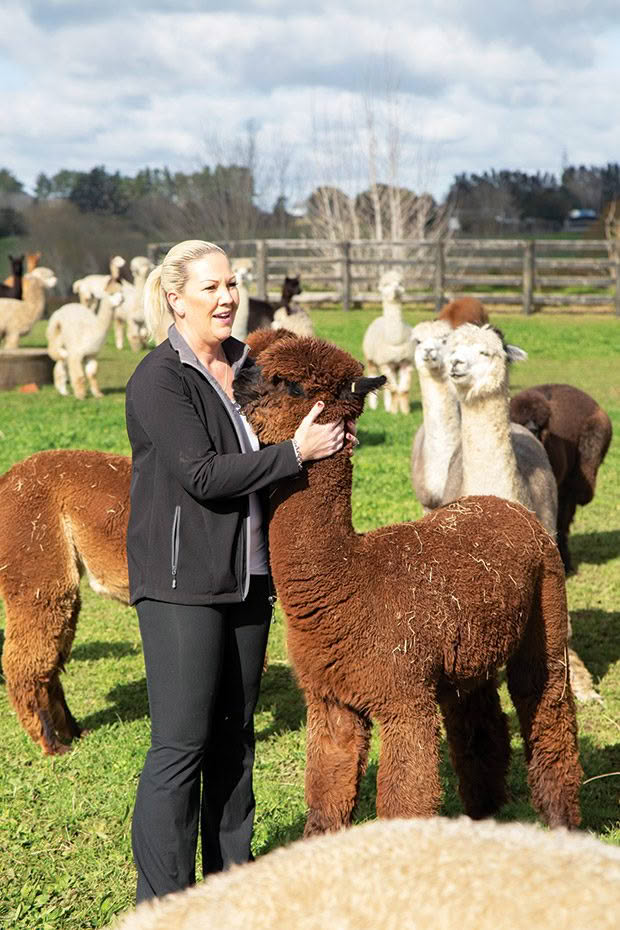
Doing it that way can mean breeding champions takes 10-15 years. The Charteris family didn’t want to wait and thanks to modern reproductive techniques, they didn’t have to. Every year, their best eight or nine females go on a special drug regime to make them super-ovulate, where they release multiple eggs instead of just one. A team of surrogates is also injected to make their bodies think they are pregnant.
The super ovulators mate as normal with the best machos (male alpaca).
“The females will sit down, and it’s like a train,” says Lisa. “All the girls sitting quietly in a row waiting their turn for the male.”
Specialist vet Jane Vaughan flies in from Australia to spend a day harvesting the fertile eggs. Toni and Lisa turn what is usually their farm shop into its other incarnation as a fully-equipped surgery. A kitchen out the back becomes a laboratory.
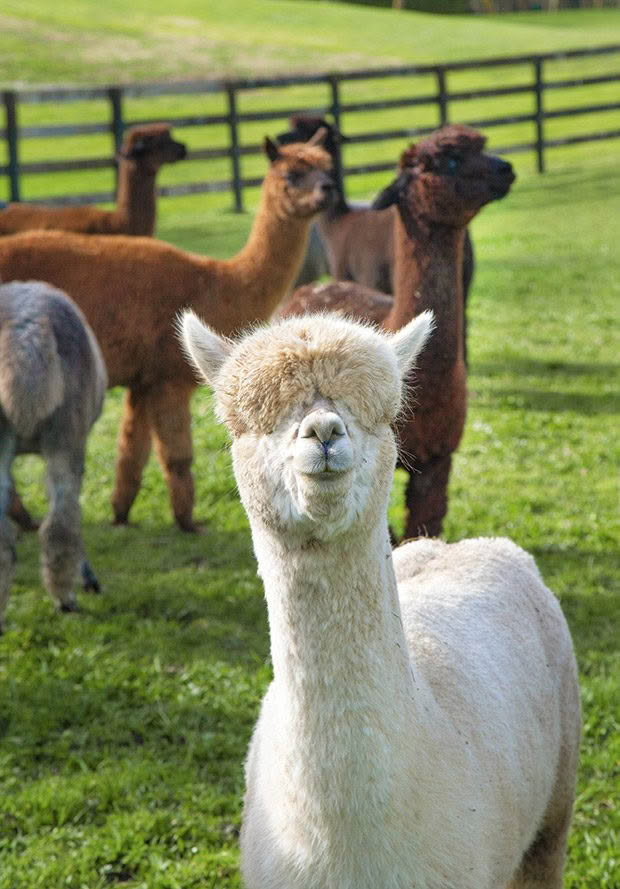
“(Jane) flushes their uterus, and you can get multiple embryos from one female. We bring in the ‘receps’ (recipients or surrogates), the embryos are implanted, they go back out into the paddock, and they’re pregnant.”
A year later, Toni and Lisa welcome multiple crias from the same parents.
“It’s expensive to do, but it does speed up the process,” says Lisa. “That’s how we’ve got so many alpaca so fast. You can have 30 born in a year.
“We’ve got one female who gives us 14-18 embryos every time. We can get 18 babies… that would normally take 18 years to produce.”
Out of the 18, Lisa estimates approximately a quarter will be ‘pet’ quality, a quarter will be ‘ok’, and a quarter will be good for showing. The final quarter will be the stars and sold overseas.

“If you had to wait 18 years, it would be so hit and miss. It’s just like with human brothers and sisters; you can have the same parents, but they can be very different children.
“Sometimes, someone gets a freak of nature, a great alpaca that’s come from a very average father and mother. But you’ll probably never recreate that again (in their lifetime).”
There are no guarantees on what colour you’ll get, even from two white alpacas.
“You can put two whites together and think you’ll get a white cria. But sometimes you’ll get a light fawn or a dark fawn because there’s a colour in their (genetic) background.”
Waters Edge Alpacas have eight of the 22 different colours. “Some breeders specialise in black, or just in white, but we’re focused on grey. Grey is recessive in alpaca and that poses challenges in breeding programmes. The final outcome, when you produce a good quality grey, definitely makes the challenge worth it.”

The NZ alpaca herd numbers over 26,000 according to a 2015 estimate by the NZ Alpaca Association. Three-quarters are breeding animals, registered with the association, but there are thousands more unregistered animals kept as pets. Alpaca are bred worldwide for their fibre. Good quality fibre becomes clothing; poorer quality is used in insulation and to stuff duvets.
In NZ, the total herd is small compared to the 3.5-4 million+ world population, so most breeders pool their fibre to sell it. Animals are shorn once a year, usually in spring to early summer to help animals keep cool. The fibre is sorted by its width in microns, something a good breeder can estimate by feel.
“Generally, the darker the colour of the animal, the higher the micron is going to be,” says Lisa. “Normally, white animals have the finest micron.”
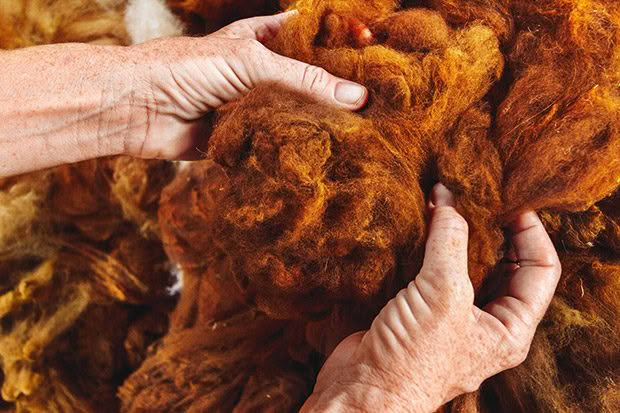
Pacific Fibres buy alpaca fibre based on its thickness in microns, not colour. That’s why Toni often sells her grey fibre separately.
“You’ll get the odd independent person who wants to process only grey and spin it themselves,” says Lisa. “They’ll pay a bit more and buy all of our 20-30 bags.”
The other way good NZ breeders can make money is selling live animals. Lisa says their Facebook page is instrumental in showing buyers the quality of their herd. She sends an interested buyer photos of the fleece and animals, and show records. If the buyer is overseas, an animal is put into quarantine for 45 days and has a variety of tests. It’s then transported in a
22 different colours.
“Some breeders specialise in black, or just in white, but we’re focused on grey. Grey is recessive in alpaca and that poses challenges in breeding programmes. The final outcome, when you produce a good quality grey, definitely makes the challenge worth it.”

The NZ alpaca herd numbers over 26,000 according to a 2015 estimate by the NZ Alpaca Association. Three-quarters are breeding animals, registered with the association, but there are thousands more unregistered animals kept as pets. Alpaca are bred worldwide for their fibre. Good quality fibre becomes clothing; poorer quality is used in insulation and to stuff duvets.
“Generally, the darker the colour of the animal, the higher the micron is going to be,” says Lisa. “Normally, white animals have the finest micron.”
Pacific Fibres buy alpaca fibre based on its thickness in microns, not colour. That’s why Toni often sells her grey fibre separately.
“You’ll get the odd independent person who wants to process only grey and spin it themselves,” says Lisa. “They’ll pay a bit more and buy all of our 20-30 bags.”
The other way good NZ breeders can make money is selling live animals. Lisa says their Facebook page is instrumental in showing buyers the quality of their herd. She sends an interested buyer photos of the fleece and animals, and show records. If the buyer is overseas, an animal is put into quarantine for 45 days and has a variety of tests. It’s then transported in a special crate by plane to its new home.
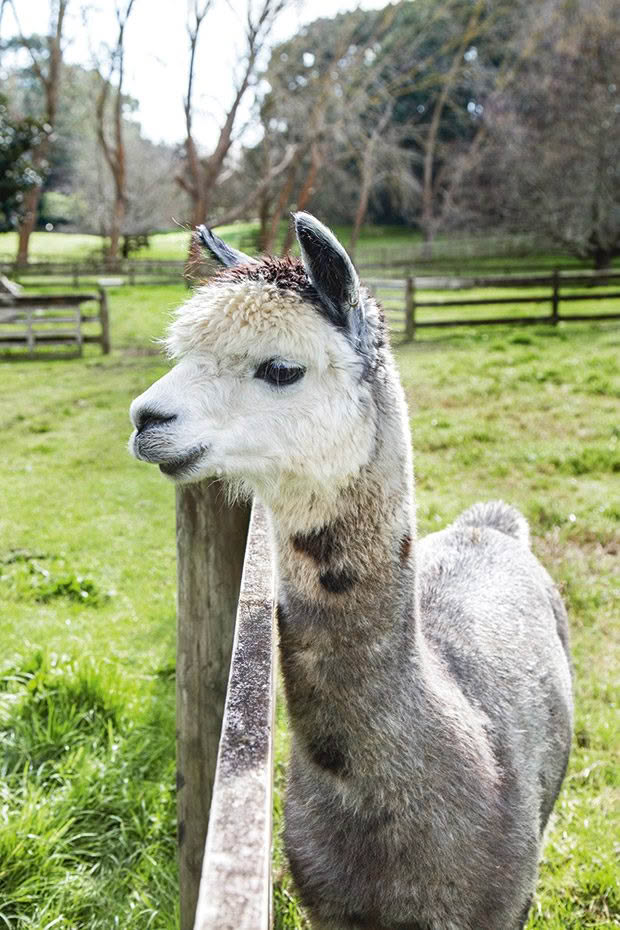
Waters Edge has exported alpacas to the UK, Germany, Sweden, Switzerland, Norway, Belgium, France, and Italy.
Does all that make alpaca farming profitable? Even her parents, with their high herd numbers, consider alpacas a hobby. Toni and Greg Charteris are nearing retirement age but are still busy running their successful construction company which works on building projects around the Pacific.
“A lot of people would see it as a hobby that pays its way,” says Lisa. “A lot of other breeders might take offense at the word ‘hobby’ because it’s their livelihood. For us, because mum and dad have got their own business and I’ve got my own business, it’s a very rewarding hobby.
“For other people, it’s their income, and they work really hard at it.”
Lisa has turned her wedding show skillset to organising this year’s National Alpaca Show, which is in Auckland for the first time. She’s expecting up to 200 animals to be judged over two days at the NZ Bloodstock venue, usually the home of NZ’s top horse sales.
Showing alpaca is quite simple in terms of preparation. Horse and cattle people spend hours washing, primping, and painting oil on hooves. Alpaca people get it much easier.

“You can’t do anything to their fleece,” Lisa explains. “Putting water on will wreck them. If we have an outside show and it rains, the fibre loses its structure, so it’s harder to see the crimp. All the fine hairs stick to each other, so it looks like a really coarse hair when it’s not.
“If you were to brush it, you could brush out that nice crimp and the fine hairs, and it would look terrible so we don’t touch them.”
Lisa says their alpaca are put onto ‘clean’ pasture a few days before a show – “alpaca love rolling in dirt. The bonnet (the tuft of fibre between the ears) and hooves are trimmed, and they’re kept out of the rain.
The show is a complicated business that has taken months of work for Lisa, and a band of NZ Alpaca Association volunteers. Two weeks before the animals arrive, the best fleeces in NZ will be judged for quality at the local hall.

“Some people only show their fibre – they never show their animals – so we have one judge who does that, and a different person judges the show animals.”
It takes a small village of people to complete the fibre judging. Fleeces are assessed on their fineness and density. Each one is weighed (the denser the fibre, the more it weighs). An experienced judge will know the approximate microns by sight and feel. But for the national show, samples from each fleece are put through a machine to get the exact measurement.
“Everyone is trying to breed for fineness and density,” says Lisa. “The finer it is, the nicer it’s going to feel on your skin so it’s going to be worth more and made into clothing. But you also want to have density; that’s how many hairs are coming out of one follicle. The denser it is, the more fibre on that animal which is going to weigh more and you’re going to get more money for it.”
Fleece is also evaluated by colour. White fibre is naturally the finest and black the coarsest, so the different colours are judged separately to keep things fair.
On show day, judging is a complex mix of the best animal of all colours by age, the best animal of each colour by age, and the best animal of all, by age. Finally, the best animal in the show receives the supreme champion trophy.
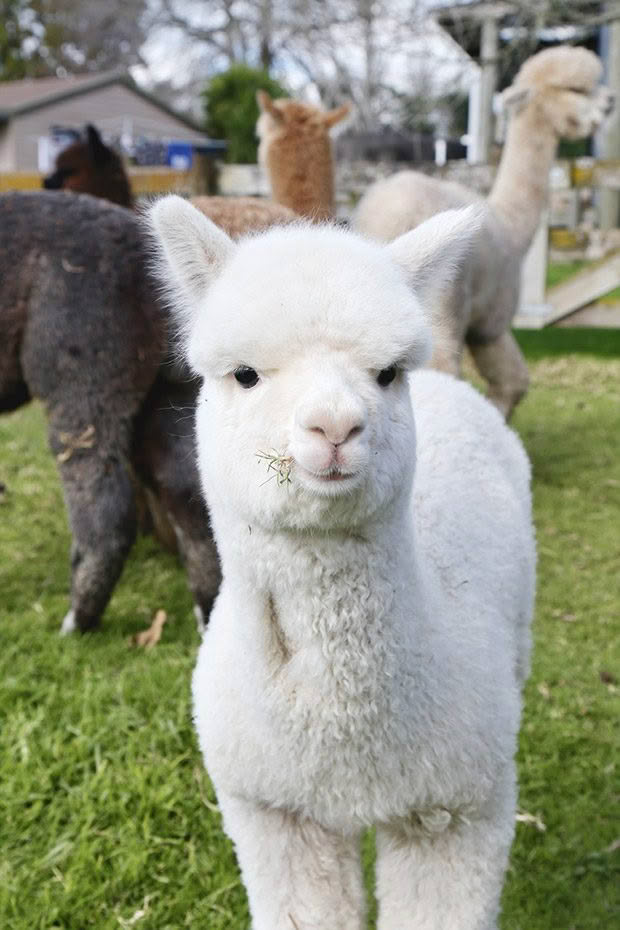
Lisa has just finished part of her training to become a qualified judge in both NZ and Australia, topping the class in a course held in Melbourne earlier this year. A lot is going through a judge’s mind when they’re looking at an animal.
“Conformation (the animal’s shape and structure) is very important. You want the males to have good bones and strong hindlegs (for mating). The female needs to be structurally sound to carry babies. There are lots of disqualifying faults in an alpaca that you would never want to breed: undershot jaws, leg conformation, ears, tails, reproductive organs, their body in general.”
The perfect alpaca will have a neck length two-thirds the length of its back. “If you look at an alpaca and its neck is really short, its legs are really short, aesthetically you wouldn’t want to breed off it, and it wouldn’t do well in the show ring.”
The breeders who go to shows are very serious about their work. Lisa estimates the average herd size for a good show competitor would be 40-80 animals. Some of the bigger herds are around the 250-500 mark, but most only bring a small team of their best animals.
Lisa is looking forward to putting her judging eye into practice at the show, and says it’s always a hugely educational process for her.

“As a judge in the ring you get to see everybody’s breeding decisions.
“At the start, I wanted to be a judge because I wanted to do something to further myself and to be able to make better breeding decisions for mum and dad. Now, it’s also about educating other breeders and helping them.”
Lisa says the knowledge she’s gained as a judge is very rewarding.
“People who have been (farming alpacas) for years have asked a question, and I’ve been able to answer it, and it’s a really good feeling.”
The Charteris family will have 8-10 of their best animals at the 2019 National Alpaca Show, which gets underway in Karaka on October 12.
ALPACAS AT A GLANCE
■ part of the camelid family, along with llama, guanaco, and vicuna, native to Peru, Chile, and Bolivia;
■ believed to have evolved from wild vicuna;
■ are often confused with llamas, but are about half the size, standing just under 1m at the shoulder, and half the weight (70kg or so, vs 150kg for llamas)
■ have ‘teddy bear’-like faces and straight ears, vs llamas which have longer, broader snouts and bent, ‘banana’-like ears;
■ have three stomachs (not four, like other ruminants), so they eat less grass but use it very efficiently, enabling them to survive on sparse mountain terrain;
■ can live 15-20 years;
■ come in 22 colours;
■ huacaya (wuh-kai-ya) alpaca are the most common type in NZ, with a thick fleece that stands perpendicular to the body;
■ suri (sue-ree) alpaca are rarer, making up about 10% of the national herd – their fibre grows in long silky locks which sit parallel to the body.
Love this story? Subscribe now!
 This article first appeared in NZ Lifestyle Block Magazine.
This article first appeared in NZ Lifestyle Block Magazine.
